by
Paul Conton
I took up gardening only a few
years
ago. They say it is the pastime of old men, so this was perhaps not
inappropriate. I have spent a lot of time thinking about Sierra Leone
and West Africa's problems, and like a lot of other people have come to
the conclusion that these are intricately linked with West African
agriculture. It baffles me that European farmers can grow crops and
ship them all the way to West Africa profitably, whilst we, with much
lower labour costs and better growing conditions for many crops, have
difficulty selling abroad. So, a few years ago, on family-owned
property already well-populated with greenery on the outskirts of
Freetown, I decided to set up a
small (less than one acre) farm to see if I could make any money from
agriculture and help to explain why West African agriculture does so
poorly compared to the rest of the world and why huge tracts of
West
African land lie idle in the face of overwhelming West African poverty.
This was my big effort to rescue West African agriculture!
As of today, the plan is to grow 150 - 200 fruit trees and sell much of the produce right outside the farm gate. I select paw-paw and citrus as my main fruit, with a sprinkling of avocado pear, sweet-sop, sour-sop and 'chuk-chuk' plum. In the main these fruit all command a high price in the local market. The citrus trees do not include orange, which are two a penny in season, but tangerine and pink grapefruit. The first plantings take place in 2014 and continue every rainy season. I quickly discover that the safest way to ensure fast-growing African weeds do not overwhelm your young fruit plants is to plant them in a nursery and transplant when they have grown reasonably large.
The paw-paw is a fast-growing tree, producing fruit in little more than a year, compared to five years or more for citrus. So, to start off, I planted a majority of paw-paw. I found out, however, that the paw-paw grows fast and dies fast. The first year's planting lasted no more than a year, without producing any fruit at all. For some unexplained reason the crop shot quickly up and then began to wither. Trees that developed luxuriant foliage suddenly changed for no apparent reason and eventually simply toppled over. This was a harbinger of worse to come.
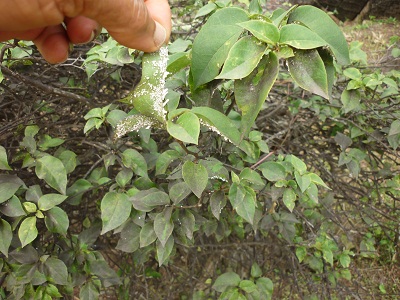
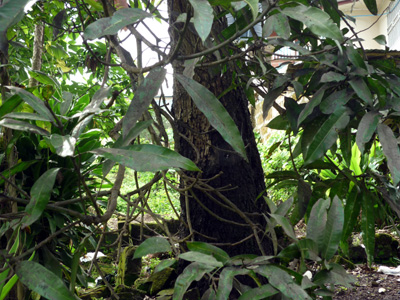 One day, I
notice a
bougainvillea shrub,
formerly luxuriant, now almost
denuded.
When I look at the few remaining leaves I see a black film stubbornly
coated on the top side, with a loose white powder coating the bottom
side. As I inspect my trees over the next days it slowly dawns on me
that a fungal infection has virtually overcome my farm. A large number
of shrubs and trees, perhaps 50% are affected. Some are in the
terminal stages of decline. Some seem to be
suffering silently, a little more resilient. The
paw-paw at least
appear unaffected, at least on the outside. Larger trees too, avocado
pear and walnut appear unaffected. Mango (right) appears to
show signs of infection, albeit contained. My
red garden shrubs (below, sorry, don't know the name) are decimated.
One of my yellow garden
shrubs is almost completely denuded. The
other, right next to it, retains a reasonable amount of foliage.
One day, I
notice a
bougainvillea shrub,
formerly luxuriant, now almost
denuded.
When I look at the few remaining leaves I see a black film stubbornly
coated on the top side, with a loose white powder coating the bottom
side. As I inspect my trees over the next days it slowly dawns on me
that a fungal infection has virtually overcome my farm. A large number
of shrubs and trees, perhaps 50% are affected. Some are in the
terminal stages of decline. Some seem to be
suffering silently, a little more resilient. The
paw-paw at least
appear unaffected, at least on the outside. Larger trees too, avocado
pear and walnut appear unaffected. Mango (right) appears to
show signs of infection, albeit contained. My
red garden shrubs (below, sorry, don't know the name) are decimated.
One of my yellow garden
shrubs is almost completely denuded. The
other, right next to it, retains a reasonable amount of foliage.
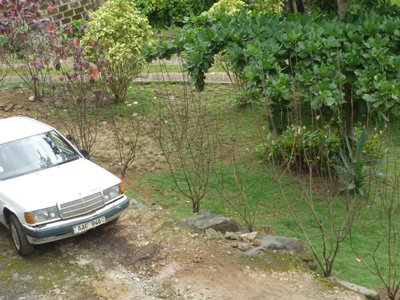
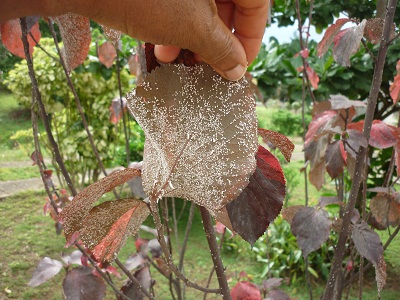
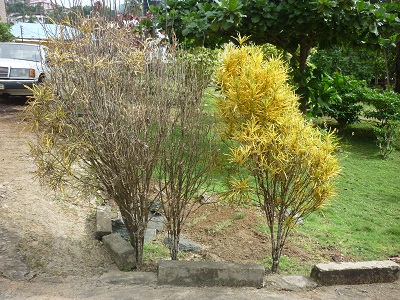
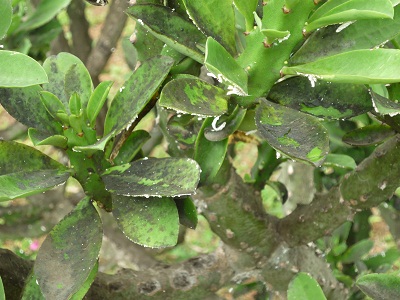
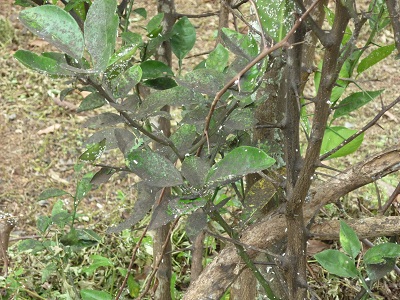 Even my cactus, which I think of as a
hardy desert plant, is not spared.
My precious citrus appears particularly vulnerable with almost all
trees and young plants affected to a greater or lesser extent. Some of
the trees are displaying dieback, losing foliage as the extremities dry
up. Some species and/or individual plants appear able to weather the
storm, losing all their foliage and then slowly recovering (this is in
the rainy season!), like the yellow shrub and bougainvillea. Other
species and/or plants do not survive, probably including the red shrub.
One red hibiscus surrounded by suffering trees and shrubs seems
completely unaffected.
Even my cactus, which I think of as a
hardy desert plant, is not spared.
My precious citrus appears particularly vulnerable with almost all
trees and young plants affected to a greater or lesser extent. Some of
the trees are displaying dieback, losing foliage as the extremities dry
up. Some species and/or individual plants appear able to weather the
storm, losing all their foliage and then slowly recovering (this is in
the rainy season!), like the yellow shrub and bougainvillea. Other
species and/or plants do not survive, probably including the red shrub.
One red hibiscus surrounded by suffering trees and shrubs seems
completely unaffected.
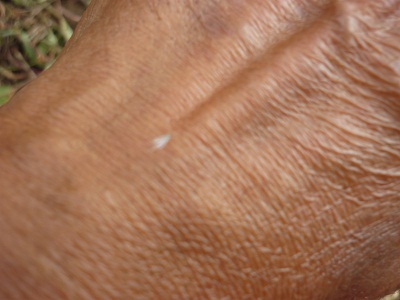
 I
notice a tiny (really tiny, much smaller than a mosquito) white insect
that floats around in the vicinity of affected foliage. It seems to be
connected to the infection in some way.
I consult the internet and am even more dismayed by what I find out.
Hundreds of tropical fungi have
been identified, all with exotic
scientific names. The stuff spreads through the air, via insects and
even through the soil. A multitude of insects could have a role
in the spread of the infestation. I learn of powdery mildew and sooty
mold and whitefly,
which has hundreds of different species. The white insects I see,
though widespread, do not seem numerous enough to have caused such
damage. Insect vectors may cause or promote the spread of the
infestation, which now looks like two separate infestations, a black
and a white. Plant disease is widely documented on the internet, but in
the most general of fashions. Many insect and fungal repellents exist,
which may or may not have an effect on the many, many infestations that
have been identified in different climates on different plant species.
From the literature, nothing is certain: this might be the cause or it
might not; that might work or it might not. How can I get rid of this
threat? I try spraying with a household
insecticide, but the results to this point are indeterminate. I need to
get a fungicide. Don't know if they are available in town. On
plants that have been engulfed by fungus, another, much larger, fly
shows up. I'm not sure what it's doing. It looks like it may be feeding
on the black fungus. In which case it's helping and if I use pesticide
I
may actually be helping the fungus. Don't know what to do. The
horticultural section of the Ministry of Agriculture provides little
help. Am I ruined?...
I
notice a tiny (really tiny, much smaller than a mosquito) white insect
that floats around in the vicinity of affected foliage. It seems to be
connected to the infection in some way.
I consult the internet and am even more dismayed by what I find out.
Hundreds of tropical fungi have
been identified, all with exotic
scientific names. The stuff spreads through the air, via insects and
even through the soil. A multitude of insects could have a role
in the spread of the infestation. I learn of powdery mildew and sooty
mold and whitefly,
which has hundreds of different species. The white insects I see,
though widespread, do not seem numerous enough to have caused such
damage. Insect vectors may cause or promote the spread of the
infestation, which now looks like two separate infestations, a black
and a white. Plant disease is widely documented on the internet, but in
the most general of fashions. Many insect and fungal repellents exist,
which may or may not have an effect on the many, many infestations that
have been identified in different climates on different plant species.
From the literature, nothing is certain: this might be the cause or it
might not; that might work or it might not. How can I get rid of this
threat? I try spraying with a household
insecticide, but the results to this point are indeterminate. I need to
get a fungicide. Don't know if they are available in town. On
plants that have been engulfed by fungus, another, much larger, fly
shows up. I'm not sure what it's doing. It looks like it may be feeding
on the black fungus. In which case it's helping and if I use pesticide
I
may actually be helping the fungus. Don't know what to do. The
horticultural section of the Ministry of Agriculture provides little
help. Am I ruined?...
...--->NEXT (West African Whitefly and Fungal Infestation)
As of today, the plan is to grow 150 - 200 fruit trees and sell much of the produce right outside the farm gate. I select paw-paw and citrus as my main fruit, with a sprinkling of avocado pear, sweet-sop, sour-sop and 'chuk-chuk' plum. In the main these fruit all command a high price in the local market. The citrus trees do not include orange, which are two a penny in season, but tangerine and pink grapefruit. The first plantings take place in 2014 and continue every rainy season. I quickly discover that the safest way to ensure fast-growing African weeds do not overwhelm your young fruit plants is to plant them in a nursery and transplant when they have grown reasonably large.
The paw-paw is a fast-growing tree, producing fruit in little more than a year, compared to five years or more for citrus. So, to start off, I planted a majority of paw-paw. I found out, however, that the paw-paw grows fast and dies fast. The first year's planting lasted no more than a year, without producing any fruit at all. For some unexplained reason the crop shot quickly up and then began to wither. Trees that developed luxuriant foliage suddenly changed for no apparent reason and eventually simply toppled over. This was a harbinger of worse to come.









...--->NEXT (West African Whitefly and Fungal Infestation)